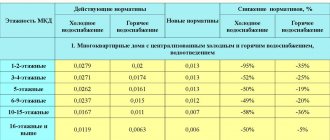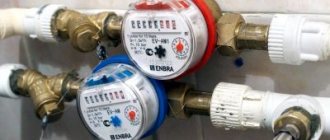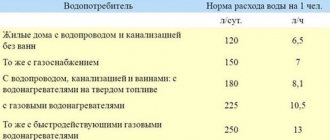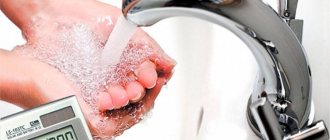Consumption standards in the city of Moscow for housing and communal services
Also in the capital, separate gas standards are applied. They depend on the number of people living in the apartment.
Presented as follows:
- if a citizen lives alone and his living space is equipped with a gas stove, then the standard is 50 m³/person. per month;
- when a family lives in an apartment equipped with a gas stove – 45 m³/person. per month;
- if there is hot water supply in the living room - 8.3 m³/person. per month;
- if the apartment is equipped with a gas stove and water heater - 20.8 m³/person. per month;
- when there is no central water supply and there is a gas stove - 10.4 m³/person. per month.
The specified standards will also apply in a situation where the premises are not equipped with metering devices. When the house is not gasified, and the citizen uses a gas stove, there will be no need to pay for the resource in question.
The consumption standards for heat, water, gas and electrical energy are increased by a factor in a situation where a citizen should have equipped the premises with metering devices, but did not do so.
In this case, the provisions of Decree of the Government of the Russian Federation of April 16, 2013 No. 344 are applied, which specifies increasing values for calculating the amount of payment for housing and communal services.
They are presented this way:
- at the beginning of 2021 – 1.7;
- from 2021 – 1.8;
- at the beginning of 2021 – 1.9.
As a result, the citizen has to pay the increased cost of the resources provided.
Thus, standards for consumption of services in the housing and communal services sector within the capital are controlled by the executive system. The established values change every year.
| Drinking water tariffs | Tariffs for sewerage | |||
| Consumer groups | from 01/01/2021 to 30/06/2021 | from 07/01/2021 to 12/31/2021 | from 01/01/2021 to 30/06/2021 | from 07/01/2021 to 12/31/2021 |
| Population (including VAT) | 42,30 | 30,90 | ||
| Other consumers (excluding VAT) | 35,25 | 25,75 | ||
| Organizations of water supply and sewerage services in the Moscow region, by place of fulfillment of obligations - the city of Moscow (excluding VAT) | 25,55 | 21,37 | ||
| Consumer groups | Name of consumers | 01.01.2021 30.06.2021 | 01.07.2021 31.12.2021 |
| Tariffs for process water supplied to consumers of the Mosvodokanal joint-stock company | Other consumers (excluding VAT) | 8,72 | 9,04 |
The Ministry of Construction approved standards for the use of water-folding devices (toilet, shower, sinks). The order was officially registered with the Ministry of Justice on September 2, 2021, but it has not yet entered into force.
- Goes to the toilet 118 times/month (about 4 times a day).
- Takes a bath 4 times a month.
- The sink is used 107 times a month.
- He showers 25 times a month.
- Uses the kitchen sink 95 times a month (3 times a day).
- Spends 31 times a month on general apartment needs (laundry, mopping, dusting).
The norm of water consumption per person - the norm for the population is established on the basis of calculations made in accordance with SNiP - building codes and regulations, taking into account the specifics of water supply technology and housing improvement. Current standards 2021 Dear readers! Our articles talk about typical ways to resolve legal issues, but each case is unique.
According to statistics, people spend much more cold water than hot water. For this reason, the consumption rate for the latter is set at 4.7 cubic meters per person per month. This value is not final.
- Г – number of citizens registered at the address;
- N – current standard for resource consumption;
- K – increasing coefficient (for 2021 it is equal to 1.5);
- T – water tariff, which is approved by local authorities.
It has been determined that a person spends more cold water than hot water. Therefore, the monthly standard for it is slightly lower and amounts to 4.745 cubic meters . At the same time, calculations are made separately for water entering the heating system.
It was calculated that on average a person can consume 6.935 cubic meters of cold water per month. What made up this figure? We regularly spend resources on daily needs, without which the concept of a comfortable life is impossible.
How does the state calculate standards?
In May 2011, Resolution No. 354 of the Russian Federation established the consumption rate for cold and hot water, taking into account drainage.
Water consumption standards in the Russian Federation. Table.
The foundations of these norms were developed quite a long time ago, during the USSR, and have only changed slightly since then. In accordance with these standards, here is how much water a person should have enough per month (liters):
- taking a shower – 900;
- cooking – 100;
- washing – 100;
- everyday activities (washing and washing dishes) – 100;
- bath once a week – up to 800;
- toilet, etc. – 500.
The standards were calculated as follows: data was collected from several apartment buildings, after which they were divided by the number of residents. The payment rate was set to cover all costs.
Standards for Cold and Hot Water in Moscow 2021 Without a Meter
For example, if only one citizen is registered in an apartment, but several live, installing a meter is not advisable for the reason that the consumption exceeds the norm, which will result in an unreasonable overpayment. At the same time, if, on the contrary, there are fewer residents compared to the number registered, the installation of meters becomes extremely important.
Additionally, 5% is also charged on the standard amounts for general household needs. Quite significant notes are established to the current standards, and, in particular, it is worth noting the fact that the total amount of costs in an apartment not equipped with metering devices should be less than the standard per person, doubled.
Service providers that are included in a specially created state Register of Companies are annually required to provide economically justified costs for the next calendar year to the sectoral Departments of the governments of the constituent entities of the Russian Federation.
As a comparison, it can be noted that in Ufa the cost of cold water (per 1 cubic meter) is on average about 13 rubles, hot – 60 rubles, in the capital – 30 rubles for cold water and 135 for hot.
There are also losses and other costs of water that may affect the entire residential building. This includes general house needs for cleaning common areas, costs associated with unauthorized connections, leaks in the water supply system of the house and many other factors.
If the meter is not installed, then the apartment owner must pay the rate monthly, depending on how many people are registered in the living space. This means that even if no one lives in the apartment and water is not consumed at all, but there are 5 people registered in it, you will need to pay for each according to the norm.
- The cost of cold water supply for the population is calculated using the formula:
- Tskhv = n*N*T*K,
- wherein:
- n – number of people registered in the apartment;
- N – consumption standard for one person;
- T – the size of the regional tariff, depending on the cost of supplying water to a house or apartment;
- K – increasing coefficient assigned by utility organizations to calculate the payment amount.
Note! The size of the increasing coefficient is approved at the regional level; it cannot be more than 2.
It is estimated that about 7,000 liters of cold water are consumed by one person every month. The following factors influence the amount of consumption:
- climate of the region;
- seasonal changes;
- used household appliances;
- technical condition of shut-off valves;
- personal habits and lifestyle of people.
We recommend: Electric meter plugs
It has been confirmed that in warm climates, cold water is consumed more intensively than in cold climates. The situation is similar with the seasons.
Water consumption increases when the water taps and flush tank in the toilet are not properly sealed, and when wasteful plumbing and household appliances are used.
According to statistics, the volume of hot water consumed is half that of cold water. The average monthly consumption rate for hot water supply is set at 3 thousand liters.
A separate payment for hot water supply is due to the fact that additional resources are used to heat water, requiring appropriate compensation. In addition, different organizations provide water heating and supply, which requires separate payment from consumers.
Is there any benefit to installing meters?
The meter allows you not only to determine the amount of boiling water consumed and cold water consumption per person per month, but also to find out how much money you have to spend on paying off utility bills.
Division of personal account in a privatized apartment -. How to find out rent arrears on a personal account - read here.
Calculation of the cadastral value of a land plot.
When paying a utility bill calculated using a common building meter, the homeowner or tenant may have to overpay monthly. This is due to the fact that the total water consumption in the house is divided among all residents.
Experts recommend connecting an individual meter. It will allow you to determine how much water is used daily and monthly in an apartment or private house. In addition, it can be used to easily detect leaks or data discrepancies in the payment receipt.
Thus, installing an apartment individual meter allows you to significantly save money. The tenant pays exclusively for the water he used during the month. Installing a meter is an inexpensive pleasure (in Moscow, the average cost of connection is about 3,500 rubles).
Water tariff without meter 2021 per person: how to calculate?
A unified methodology for calculating payments for cold and hot water supply has been approved by law. Water tariffs in regions vary and take into account the following factors:
- climate features;
- degree of wear and tear of fixed assets;
- population density;
- the cost of other energy resources - electricity, solid fuel, etc., used to supply water;
- the cost of living, which affects the level of wages of employees of utility companies and other less significant circumstances.
On average in the Russian Federation, monthly standards are set as follows:
- cold water - from 4 to 7 cubic meters at a price of 25 to 38 rubles per 1 cubic meter;
- hot water - from 2.5 to 4.7 cubic meters costing from 80 to 190 rubles per 1 cubic meter.
The supply of water to private houses in rural areas is subject to rationing in the case of centralized water supply to consumers by utility companies. It is possible to assign a separate payment if there is a water stand on a public street.
We recommend: Where and how you can find out the serial number of your water meter
It must be taken into account that water is additionally consumed for watering the garden, therefore, in the appropriate season, if there is no water meter in a private house, a separate fixed amount is assigned for these needs.
If residents of the private sector do not provide water supply centrally, including installation and maintenance of systems, utility standards are not applicable in this situation.
The possibility of additional savings is achieved by using the following technical means:
- installing shower cabins instead of bathtubs - the cost of these hygiene procedures is reduced by more than half;
- separate purchase of water for cooking - up to 50 liters of water are saved monthly;
- the dishwasher saves up to 20% of consumption per month;
- washing machines – infrequent washing of more items reduces water consumption by up to 10%;
- A toilet cistern with two flush options and economical plumbing reduces consumption by up to 15%.
A thrifty attitude to energy resources plays an important role - up to 15 liters of water are consumed every minute through an open tap when brushing your teeth, most of which is wasted.
Recently, citizens have been forced to install meters in their apartments and houses. If the homeowner does not use them, then he must pay based on standards to which special coefficients are applied that increase the cost of water resources. Thus, paying for cold or hot water without a meter becomes financially burdensome.
Provisions related to paying for water according to standards, that is, without a meter, have recently acquired legal and economic justification.
In particular, the rules governing the supply of utilities, which were introduced by Government Decree No. 354 of the Russian Federation, clearly regulate the procedure for calculating payment amounts for utility services, but this act does not establish the very norm for the use of water resources by the population.
How to reduce water consumption costs
We offer some tips on how to reduce cold and hot water consumption without infringing on yourself and your loved ones with whom you live. These recommendations will help save your family budget.
- install aerators on all taps that limit the pressure, then it will automatically decrease, the aerator adds air to the stream, making it stronger;
- wash with the washing machine fully loaded;
- A dishwasher will help reduce consumption by 20%;
- monitor the serviceability of the drain tank and taps, eliminate leaks immediately;
- do not take a full bath, give preference to a shower;
- use the toilet flush wisely; it is advisable to install the tank in two flush positions;
- Install economical faucets on a hot pipe; you will not have to constantly turn up and adjust the temperature while the water is draining.
Standard consumption of cold and hot water per person per month without a meter
The planned increase in prices for utilities will not affect the following preferential category of citizens:
- people who have retired;
- persons of the Russian Federation who have the status of a pensioner based on length of service;
- disabled people due to health or work;
- veterans.
In order to receive preferences for public services, a citizen must submit an application to the resource supply company or management company. When applying, you must have with you a passport and a document confirming the right to receive benefits when paying your water bill.
The cost of hot water in Moscow includes, in addition to the use of the resource, several more consumable items:
- The price of electrical energy consumed by the station.
- Supplies supplied to homes are subject to regular cleaning in accordance with sanitary and epidemiological standards. This is done with special reagents. Their cost and the cost of cleaning work are included in the tariff.
- The wage fund + social contributions of employees are proportionally distributed over the entire volume of liquid consumed.
- Additional expenses of the water utility: rental of premises, purchase of equipment, expenses for temporary operation of various equipment. They are also distributed proportionally to all consumers.
- Taxes on resources, repair of stations and networks. These expenses are charged similarly to the accounts of owners of apartments and private houses.
- In addition, the amounts spent on eliminating the natural results of water use fall on the overall cost indicators. Accordingly, they are included in the tariff.
The cost of a cube of hot and cold water in Moscow for 2021 is regulated by the Russian government. In some regions, local authorities have the power to make minor tariff adjustments.
Prices per cube of hot water and cold water are subject to increase from this year. The increase is carried out in two stages. Since the beginning of 2021, the cost per 1 m3 of liquid has already increased by 1.7%. The second wave of tariff increases is scheduled for July. The price will change by 2.1% upward.
Specifically for Muscovites and residents of the region, the municipality announced prices for 2021 for the first six months of this year:
- 1 m3 of cold water is 38.06 rubles;
- one cubic meter of hot water – 125.69 rubles.
Please note: Moscow and Moscow Region are included in the list of regions that have the right to change tariff rates in relation to the entire country. Therefore, the local municipality decided to increase the price of water in the second half of 2021 by 5% compared to the previous reporting period.
The price of hot water per cubic meter in Moscow, as well as for cold water, is formed in a similar way. The presence of accounting and measuring equipment (IME) in the apartments significantly influences the final result.
If a resource consumption meter is not installed on a property, then the cost of hot and cold water in Moscow is affected by the number of residents/registered people in the living space.
The average resource consumption per person in a given region is multiplied by the number of citizens. If there is an installed control and measuring device, then the formula for calculating payments includes the number of cubes used multiplied by the tariff.
It has been determined that a person spends more cold water than hot water. Therefore, the monthly standard for it is slightly lower and amounts to 4.745 cubic meters . At the same time, calculations are made separately for water entering the heating system.
The standard includes only actual consumption figures for each person and it is believed that no more than 140 liters of hot water are consumed daily for all his needs. The same rule applies here as with cold water, when utility companies can increase the standard no more than twice. And you need to pay according to the standard for each citizen registered in the living space.
The formula for calculating the fee for hot water is similar to the calculation for cold water using the cost of 1 cubic meter of hot water according to the regional tariff.
Note that by dividing the consumption rate of hot and cold water by 30 days in a month, we get quite serious numbers. This more than covers all possible expenses, so meters will help significantly save your family’s water costs. This is especially true for those who have a fairly large family living and registered in their apartment.
The above standards are average. More precise figures are established by each region independently. However, depending on various factors that are present in a particular house, they differ slightly. The cost of one cubic meter of water is also determined by the regional authorities; it depends on the characteristics of the territory and its location.
The table shows water tariffs in force in different cities. They are applicable for multi-apartment and private buildings that are connected to hot and cold water supply networks, sewerage, and are also equipped with plumbing fixtures (toilet, sink, bathtub or shower).
| City | Cold water supply | Hot water supply | ||
| cubic meters/person | rub. for 1 m3 | cubic meters/person | rub. for 1 m3 | |
| Moscow | 6,935 | 38,06 | 4,745 | 188,53 |
| Saint Petersburg | 5,36 | 25 | 3,89 | 100 |
| Samara | 7,9 | 27,1 | 3,6 | 130,2 |
| Permian | 5,6 | 31,6 | 3,4 | 152,2 |
| Kazan | 6,73 | — | 3,44 | — |
| Novosibirsk | 5,193 | — | 3,687 | 89,11 |
| Voronezh | 5,1 | — | 3,07 | — |
| Krasnodar | 4,04 | — | 2,65 | — |
| Chelyabinsk | 4,25 | — | 3,11 | — |
| Ekatermnburg | 5,62 | — | 5,04 | — |
| Ufa | 6,356 | 12,15 | 2,582 | 57,2 |
| Rostov-on-Don | 6,5 | — | — | — |
| Omsk | 3,510 | — | 5,472 | — |
Please note that prices may vary depending on the resource supplying organization. For each of them, tariffs are approved separately.
| Drinking water tariffs | Tariffs for sewerage | |||
| Consumer groups | 01.01.2021 to 30.06.2021 | 07/01/2021 to 12/31/2021 | 01.01.2021 to 30.06.2021 | 07/01/2021 to 12/31/2021 |
| Population (including VAT) | 42,30 | 43,57 | 30,90 | 32,02 |
| Other consumers (excluding VAT) | 35,25 | 36,31 | 25,75 | 26,68 |
| Organizations of water supply and sewerage services in the Moscow region, by place of fulfillment of obligations - the city of Moscow (excluding VAT) | 25,55 | 26,23 | 21,37 | 22,14 |
| Name of consumers | Tariff validity period | Tariff for drinking water, rub./cub.m | Tariff for water disposal, rub./cub.m |
| Population (including VAT) | from 01.01.2022 to 30.06.2022 | 43,57 | 32,02 |
| from 07/01/2022 to 12/31/2022 | 45,28 | 33,26 | |
| from 01.01.2023 to 30.06.2023 | 45,28 | 33,26 | |
| from 07/01/2023 to 12/31/2023 | 47,09 | 34,60 | |
| Other consumers (excluding VAT) | from 01.01.2022 to 30.06.2022 | 36,31 | 26.68 |
| from 07/01/2022 to 12/31/2022 | 37,73 | 27,72 | |
| from 01.01.2023 to 30.06.2023 | 37,73 | 27,72 | |
| from 07/01/2023 to 12/31/2023 | 39,24 | 28,83 | |
| Organizations of water supply and sewerage services in the Moscow region, by place of fulfillment of obligations, the city of Moscow (excluding VAT) | from 01.01.2022 to 30.06.2022 | 26,23 | 22,14 |
| from 07/01/2022 to 12/31/2022 | 27,25 | 23,00 | |
| from 01.01.2023 to 30.06.2023 | 27,25 | 23,00 | |
| from 07/01/2023 to 12/31/2023 | 28,34 | 23,92 |
| Consumer groups | Name of consumers | 01.01.2021 30.06.2021 | 01.07.2021 31.12.2021 |
| Tariffs for process water supplied to consumers of the Mosvodokanal joint-stock company | Other consumers (excluding VAT) | 8,72 | 8,98 |
Price (tariff) in rub./cub.m
| Name of consumers | Tariff validity period | Tariffs for process water, rub./cub.m |
| Other consumers (excluding VAT) | from 01.01.2022 to 30.06.2022 | 8,98 |
| from 07/01/2022 to 12/31/2022 | 9,33 | |
| from 01.01.2023 to 30.06.2023 | 9,33 | |
| from 07/01/2023 to 12/31/2023 | 9,70 |
Cold water
Cold water consumption is calculated by the following formula: Cx = n*Np*Tp*Kp
- n – number of official residents in the apartment;
- Np – consumption rate for each resident;
- Tr – tariff established in the region;
- Kp – payment surcharge (exists to encourage residents to install a meter).
It was found that for one person per month, taking into account several conditions - 7000 liters.
- climatic conditions;
- temperature and weather fluctuations;
- tenants' efficiency;
- quality and serviceability of cranes.
We recommend: Itelma water meter (Itelma)
It is quite logical that in areas with a hotter climate, the consumption of cold water is much greater than in colder ones. The same pattern applies to climate change.
Consumption increases in cases of equipment failure and inefficiency.
What are the standards for the consumption of utilities in Moscow in 2021?
| Drinking water tariffs | Tariffs for sewerage | |||
| Consumer groups | 01.01.2021 to 30.06.2021 | 07/01/2021 to 12/31/2021 | 01.01.2021 to 30.06.2021 | 07/01/2021 to 12/31/2021 |
| Population (including VAT) | 29,51 | 30,29 | 23,77 | 24,62 |
| Other consumers (excluding VAT) | 24,59 | 25,24 | 19,81 | 20,52 |
Price (tariff) in rub./cub.m
| Consumer groups | from 01/01/2021 to 30/06/2021 | from 07/01/2021 to 12/31/2021 |
| Other consumers (excluding VAT) | 3,53 | 3,78 |
Based on the Moscow Government Resolution No. 41 dated January 11, 1994 “On the transition to a new system of payment for housing and utilities and the procedure for providing housing subsidies to citizens,” the heat supply indicator applies:
- heat energy consumption for heating the apartment – 0.016 Gcal/sq. m;
- water heating – 0.294 Gcal/person.
Residential buildings equipped with sewerage, running water, baths with hot central water supply:
- water disposal - 11.68 m³ per person per month;
- cold water – 6.935;
- hot water – 4.745.
Housing equipped with sewerage, running water, baths with gas heaters:
- water disposal – 9.86;
- cold water – 9.86.
Houses with running water with gas heaters near the bathtubs and sewerage:
- 9,49;
- 9.49 m³ per 1 person per month.
Residential buildings of hotel type, equipped with running water, hot water supply, gas:
- water disposal – 7.31;
- cold water – 4.386;
- hot – 2,924.
Houses with gas, sewer, and running water without baths:
- water disposal – 4, 57;
- cold water – 4.57 m³ per person per month.
For watering household plots from May to September, the permissible water consumption is 0.16 m³.
What determines the consumption of tap water in Moscow?
| N p/p | Consumers | Tariffs, rub./cub.m |
| 1 | Tariffs for hot water supplied to consumers (excluding VAT) | 169,92 |
| 2 | Population (including VAT) | 203,90 |
| N p/p | Consumers | Tariffs, rub./cub.m |
| 1 | Tariffs for hot water supplied to consumers (excluding VAT) | |
| for DHW systems with heated towel rails | 133,93 | |
| for heating systems with heated towel rails | 122,52 | |
| 2 | Population (including VAT) | |
| for DHW systems with heated towel rails | 160,72 | |
| for heating systems with heated towel rails | 147,02 | |
| N p/p | Consumers | Tariffs, rub./cub.m |
| 1 | Tariffs for hot water supplied to consumers (excluding VAT) | |
| for DHW systems with heated towel rails | 137,48 | |
| for heating systems with heated towel rails | 126,07 | |
| 2 | Population (including VAT) | |
| for DHW systems with heated towel rails | 164,98 | |
| for heating systems with heated towel rails | 151,28 | |
| N p/p | Consumers | Tariffs, rub./cub.m |
| 1 | Tariffs for hot water supplied to consumers (excluding VAT) | |
| for DHW systems with heated towel rails | 137,48 | |
| 2 | Population (including VAT) | |
| for DHW systems with heated towel rails | 164,98 | |
| N p/p | Consumers | Tariffs, rub./cub.m |
| 1 | Tariffs for hot water supplied to consumers (excluding VAT) | |
| for DHW systems with heated towel rails | 139,02 | |
| 2 | Population (including VAT) | |
| for DHW systems with heated towel rails | 166,82 | |
Housing and communal services tariffs from January 1, 2021 in Moscow and the Moscow region
Housing and communal services consumption standards are payment limits. According to legislative acts, if the consumption of housing and communal services by residents during the billing period exceeds the regional indicator, the supplier company must pay the difference for the resources used at its own expense.
This regulation protects property owners from economic fraud by utility providers.
Indicators of housing and communal services consumption in residential buildings are calculated using special formulas. They include many variables indicating the technical characteristics of the room, the type and degree of wear of engineering systems, etc.
The calculation of social norms is regulated by Resolution No. 306 of the Russian Federation. Also, each specific region uses its own regulations and resolutions, which complement and clarify Resolution No. 306.
Electricity is one of the most expensive and used resources. When determining the consumption rate for MKD, the following parameters are taken into account:
- Availability of elevators, electric stoves, boilers, auxiliary electrical systems.
- The area and number of rooms in the apartment, as well as the number of people living.
Electricity supply standards also depend on external factors. They take into account the average income of the local population, the area, and the number of energy generating enterprises.
The established amounts of resource accrual are legislated in regulations and approved by the executive authority.
Water supply and sanitation is calculated in terms of 1 cubic meter of water per person. Tariffs for this service vary greatly depending on the regions of residence and the architecture of the house itself.
Thus, water supply standards can be influenced by:
- Floor of the house.
- Number of apartments on site.
- State of the system.
- Level of improvement of apartments.
- Availability of hot water supply.
These indicators are also taken into account when calculating payments for sewerage.
The water consumption standards themselves are calculated by averaging all a person’s costs for taking a bath, showering, visiting the toilet, cooking, washing, washing dishes, etc. So, on average, it is generally accepted that 7 m³ of water per month is enough for 1 person for all his needs.
Residential buildings equipped with sewerage, running water, baths with hot central water supply:
- water disposal - 11.68 m³ per person per month;
- cold water – 6.935;
- hot water – 4.745.
Housing equipped with sewerage, running water, baths with gas heaters:
- water disposal – 9.86;
- cold water – 9.86.
Houses with running water with gas heaters near the bathtubs and sewerage:
- 9,49;
- 9.49 m³ per 1 person per month.
Residential buildings of hotel type, equipped with running water, hot water supply, gas:
- water disposal – 7.31;
- cold water – 4.386;
- hot – 2,924.
Houses with gas, sewer, and running water without baths:
- water disposal – 4, 57;
- cold water – 4.57 m³ per person per month.
For watering household plots from May to September, the permissible water consumption is 0.16 m³.
Further indexation of tariffs
For example, in the Lipetsk region, the tariff for the population will rise from 25.34 rubles per cubic meter of cold water to 25.87 rubles per cubic meter. For other consumers, the increase will be 44 kopecks (from 21.12 to 21.56 rubles per cubic meter). For water disposal, the population will no longer have to pay 49.86 rubles per cubic meter, but 50.86, and other consumers will have to pay not 41.55 rubles per cubic meter, but 42.38.
Rates
It should be noted that the increase in water supply tariffs that occurred at the beginning of the year did not affect all payers . So among Muscovites, only those who live in “old” Moscow began to pay in a new way. The growth was less than 2%. Residents of new areas that recently became part of the capital have not yet switched to the new tariff.
“Today, almost 97% of the housing stock in Minsk is equipped with water meters, more than 800 thousand personal accounts are registered. Nevertheless, Minskvodokanal strives to ensure that all households in the city, without exception, have meters and pay for water consumption according to their readings,” Ananich emphasized.
“For example, how much water is required per month to clean 1 square meter of staircase. Or for washing one garbage container. These standards formed the basis of our proposals. The City Council for Entrepreneurship Development supported them, now the word is up to the Minsk City Executive Committee,” the Minsk-News agency quotes a representative of Minskvodokanal.
No meter - pay more
In particular, the changes are intended for legal entities. Ananich noted that previously organizations serving multi-apartment residential buildings had one general standard for all types of services related to water consumption. Now housing and communal services are provided by different contractors, and they have different costs. To solve this problem, new water consumption standards have been developed.
Every year the government approves how much the cost of utilities will increase. That is, by how many percent can tariffs increase in a particular region? This value is called the maximum fee change index. This is how the state controls the cost of utilities so that they do not increase arbitrarily.
More to read —> At what age are baby food given out at the dairy kitchen in Kachkanar
Tariffs for housing and communal services in Moscow from January 1, 2021
The presence of meters makes it easier to calculate the monthly cost of housing and communal services. However, their use is not always possible.
In a situation where it is impossible to calculate individual resource consumption, the average regional standard is used to generate a payment receipt. This coefficient is calculated taking into account the average use of resources in a particular district.
Such indicators do not always reflect reality, because are based on planned consumption based on historical data. Regional standards are based on both the number of residents and the total area of residential premises. The average figure is derived based on the volume of consumption in houses with similar architectural characteristics.
— provides full control over tariffs for electricity, heating, water supply and sanitation. In addition, the committee monitors prices for natural gas and coal; — supervises public services and tariffs in the region.
After a government increase/decrease (although there is practically no second) in housing
—
communal
services) committee notifies residents of the region on its website.
Dmitry Medvedev signed a decree in which “It is prohibited to raise prices for housing and communal services above inflation.” The paper was signed in the summer - June 19 last year.
“I, the Chairman of the Government - Dmitry Medvedev, sign a resolution that should tighten control over the cost of housing and communal services in Russia. The increase should not be higher than the inflation rate.”
An increase in utility bills in 2021 is expected in two stages:
- by 1.7% from January 1, 2021
- by 2.4% from July 1 of the same year.
But regions will be able to increase tariffs to almost 5%, according to individual indices.
The table reflects the increase in tariffs for housing and communal services from January 1, 2021 in the constituent entities of the Russian Federation.
| Indexation of housing and communal services tariffs (in%) | Name of the subject of Russia |
| 2 | — Republic of Adygea, Republic of Mordovia, Republic of Mari El, Republic of Bashkortostan, Republic of Kalmykia, Republic of Chuvashia; — Perm region, Stavropol region; — Astrakhan region, Belgorod region, Bryansk region, Vladimir region, Vologda region, Voronezh region, Ivanovo region, Kaliningrad region, Kaluga region, Kurgan region, Kostroma region, Kursk region, Leningrad region, Lipetsk region, Nizhny Novgorod region, Orenburg region, Pskov region region, Penza region, Rostov region, Ryazan region, Samara region, Saratov region, Sverdlovsk region, Smolensk region, Tambov region, Tver region, Tyumen region, Ulyanovsk region, Chelyabinsk region, Yaroslavl region; — Autonomous Okrug KhMAO-Yugra, Yamalo-Nenets Autonomous Okrug |
| 2,2 | Oryol Region |
| 2,3 | — Arkhangelsk region, Omsk region |
| 2,4 | - Republic of Komi, Republic of Karelia, Republic of Sakha (Yakutia) - Altai Territory, Kamchatka Territory, Khabarovsk Territory - Amur Region, Volgograd Region, Magadan Region, Murmansk Region, Sakhalin Region - Nenets Autonomous Okrug, Chukotka Autonomous Okrug |
| 2,5 | Tomsk region; Altai Republic |
| 2,6 | — Krasnodar region, Primorsky region |
| 2,7 | Novgorod region; Krasnoyarsk region; Jewish Autonomous Region |
| 2,8 | — Republic of Tyva, Republic of Buryatia, Republic of Khakassia; - Kirov region |
| 2,9 | Irkutsk region |
| 3 | Republic of Tatarstan; Kemerovo region. |
| 3,2 | Transbaikal region; Novosibirsk region |
| 3,3 | — Republic of North Ossetia-Alania, Republic of Ingushetia, Karachay-Cherkess Republic |
| 3,5 | Tula region |
| 3,6 | Moscow region |
| 3,8 | The Republic of Dagestan |
| 4 | — Chechen Republic, Kabardino-Balkarian Republic |
| 0,4 | city of St. Petersburg |
| 4,8 | Moscow city |
Subsidies and benefits for paying for housing and communal services. 1. Single-parent and large families; 2. Low-income citizens of the Russian Federation; 3. Single pensioners; 4. Veterans of the Great Patriotic War or citizens equivalent to them.
Citizens of these groups can receive a discount from a minimum of 18% to a maximum of 30%. Contact social security or employees of the Ministry of Labor for an accurate calculation of the cost of housing and communal services.
A complaint statement is an official document, the preparation of which must follow certain rules:
- In the upper right corner you should place information about who is sending the application and where. You must provide your residence address and personal contact information, such as telephone number and email address (if available).
- Below, in the center of the sheet, write “Statement”, then the following: “about violation of standards for providing the population with public utilities.” Here you can specify another reason that matches the problem. Many applicants limit themselves to the title - this is acceptable.
- Below you should write the complaint itself with a detailed description of the violations identified. The address where the violation was recorded should be noted. Also in the text of the complaint you can place a link to legal documents regulating permissible deviations.
- Below you need to write an appeal to an official of the State Housing Inspectorate and place a request for an examination and troubleshooting.
- At the end, you must put your signature and the date the complaint was written.
The written application can be taken to the management company or sent there by mail or registered mail. Applications are also accepted electronically. Correct filling ensures that the process of solving a violation of the normal temperature of hot water in the tap will speed up the process. If the description of violations is incorrectly formatted, that is, written in a conversational style, contains slang words and profanity, the supplier company’s employees have the right not to consider the complaint and not to respond to the applicant.
Before you start filing a complaint, you should prepare and find out which company is responsible for providing hot water supply to the desired address in 2021. To file a claim you need:
- Write a statement according to the sample. If the application is written on behalf of several consumers, for example, neighbors, troubleshooting will take less time.
- Send a complaint to the State Housing Inspectorate. This can be done in person or by mail. In response, the consumer must receive a letter from the official, who is required to send a detailed response within thirty days of receiving the complaint. The time spent on eliminating all violations varies and averages 1.5-2 months.
During the trial, the issues of guilt of the management company and the reliability of the evidence presented by the plaintiff will be resolved. As a result of winning, the consumer can count on:
- elimination of violations and further high-quality provision of hot water supply services;
- abolition of payment for hot water from the tap in the apartment in 2021, which does not meet the requirements of SanPiN;
- monetary compensation for moral damage;
- reimbursement of the cost of household filters, which the plaintiff could have resorted to to independently troubleshoot problems;
- payment of monetary compensation for damage to property, if any.
According to a court decision, a company that fails to ensure compliance with established standards is liable under the law.
If there is objective evidence of violation of standards in 2021, the management company does not have the right to refuse to recalculate the payment for hot water supply. The consumer must submit a corresponding application with an attached examination report. After this, the supplier company has no more than five days to change the tariff. The conversion factor is 0.1% of the total cost for every 3°C deviation from the minimum acceptable standard. If the hot water temperature drops to 40°C, the calculation is based on the cost of cold water.
The amount of compensation for non-compliance with the standard temperature of hot water from the tap in the apartment is determined by the court. The defendant, that is, the management company, pays all legal costs. The amount of compensation for moral damage can range from four to six thousand rubles. The exact meaning depends on the circumstances of the case. The amount of the fine for the management company varies from two to three thousand.
There are no plans to change SanPiN for 2021, but amendments to tariffs for hot water supply are possible. They will affect certain regions, such as Tambov, Chelyabinsk, Amur and other regions.
Arbitrage practice
Non-compliance of hot water temperature with accepted standards can cause moral harm and cause physical and moral suffering to consumers. During the proceedings, the court forces the company providing the poor-quality service to compensate for the inconvenience caused. This situation was considered in case No. 2 - 974/10. The plaintiffs were citizen D. and her young son. They accused the management company of providing hot water that did not meet SanPiN temperature standards. To bathe her minor son, citizen D. had to heat the water manually. This went on for several years. The management company’s employees did not react in any way to the plaintiffs’ claims and did not take any measures to correct the problems.
In the statement of claim, D. demanded that the defendant recalculate the payment for hot water supply, eliminate violations and pay moral damages in favor of each plaintiff in the amount of 10 thousand rubles. During the consideration of the case, the court relied on Art. No. 161, 162 of the Housing Code of the Russian Federation, according to which the management company is obliged to provide citizens living in an apartment building with favorable conditions. Also, the management company must consider all complaints and appeals from consumers. The company evaded compliance with the obligations specified in the service agreement. As a result of the trial, the court decided to satisfy the claim for compensation for moral damage, recalculate and eliminate all problems associated with providing residents with hot water.
To understand how much the supplier company should reduce the payment for hot water from the tap in 2021, you can make the calculation yourself. When recalculating payments for hot water supply, you must follow the following algorithm:
- divide the total number of days on which a violation of SanPiN was recorded by the number of days in a month;
- multiply the result by the tariff rate.
The resulting number will be the amount of the discount that the consumer can charge the management company.
Electricity tariffs for industrial enterprises, heat tariffs for industrial enterprises, gas tariffs for industrial enterprises, tariffs for water supply to industrial enterprises, tariffs for waste disposal from industrial enterprises - quick links to unified summary tables on tariffs for industrial enterprises in 2021.
Moscow, Moscow region, St. Petersburg, Yekaterinburg, Novosibirsk, Kyiv, Astana, Minsk - quick links to unified summary tables on tariffs for industrial enterprises in 2021.
Moscow, Moscow region, St. Petersburg, Yekaterinburg, Novosibirsk, Kyiv, Astana, Minsk - quick links to unified summary tables on tariffs for citizens (individuals) in 2021.
Paying for water without a meter: standard water consumption per person, how much to pay
The crisis in the Russian economy has affected almost all spheres of society. The cost of services depends on gas prices. The indexation plan for enterprises developed by officials does not always turn out to be effective.
Tariffs and standards
What can we say about leaking tanks, a thin stream of water from a half-open tap, and other mistakes. Let’s say that if you don’t turn off the tap while you are using a toothbrush, up to 0.2-0.3 m3 of water uselessly pours out in a week!
The government has approved marginal indices for increasing tariffs for housing and communal services in 2021. The federal government does this every year. They decide what the maximum increase in prices for utilities will be in different regions.
More to read —> Light-curing, light-curing filling for free
How much water do you use per month?
My husband and I save water in a hard way: we pour all the water from washing dishes into the bathroom, where it accumulates to flush feces in the toilet. Our tank is completely closed! When we brush our teeth, turn off the water. We take a shower once a week. It turns out that we have 3 cubic meters of cold water per month, and 4 cubic meters of hot water.
We recommend reading: Izhd what is it
Dear ladies, please tell those who pay for cold water by meter - how many cubic meters of cold water do you use per month on average? And for how many people? We live together, but... Looking at the counter, I was amazed. how much water did I use? I want to compare. Maybe this is the norm. Thanks for answers.
How much water does one person use at home?
It is calculated that a person spends on:
- hand washing 6-8 l
- teeth cleaning 6-8 l
- showering about 14 liters of water per minute
- taking a bath about 150 l
- flushing the toilet about 6 l
- dishwasher cycle 12-24 l
- washing machine cycle - 25-50 l









